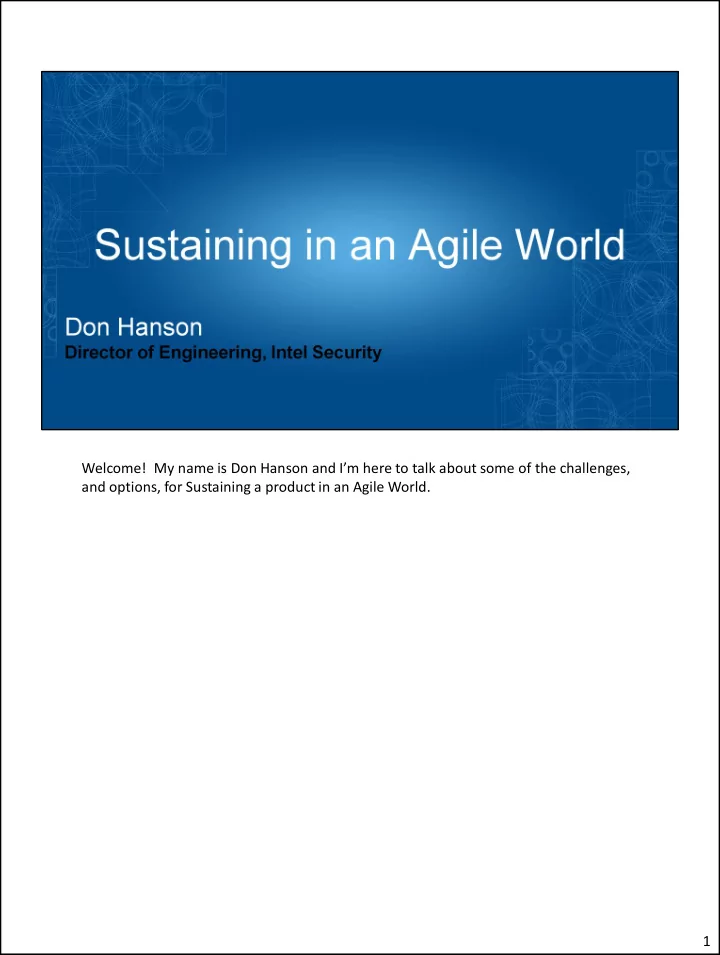

Welcome! My name is Don Hanson and I’m here to talk about some of the challenges, and options, for Sustaining a product in an Agile World. 1
So who am I? I’ve been in the industry for some time. I learned the value of a good User Experience at my first company. Where it meant the difference between Ramen one month and steak the next. - I love to tinker. 4 3D printers. (3 working) Drone enthusiast. - Kickstarter junkie I’ve been fortunate to work primarily on high risk, high reward projects. Everything from green field to massive next-gen re-architectures. Most recently working on the Data Exchange Layer, a communication fabric that is the foundation of Intel Security’s Security Connected vision. 2
So who is the presentation not for? 3
4
5
Product sustaining is a broad topic. For our purposes, I am referring to: 1) Responding to Customer complaints 2) Performed by Development team - (your support/helpdesk unable to solve, “escalated” issue to development) 3) Resolution is often a code change - (typically hot fix or patch) 4) Some form of a Performance metric that tracks how quickly issues are closed. (also known as the dreaded SLA) 6
Many groups start with the "Whole Team Sustaining" method. You've released the product. Customers are buying it. The team is happily working on the next version. ... As you can imagine this has a bit of an impact... 7
We start seeing Team members blocked Escalations take longer to fix or are incomplete. Ultimately - Velocity slows on next release. - Predicted milestones shift out. 8
So what's going on? It turns out, we're Breaking number of Agile best practices. - Escalations are interrupt driven, this causes Sprints not be atomic because the workload can change at any time. - Dependencies can't be managed - No accountability - No "Agile knobs" 9
You think about it and come up with a brilliant idea Leverage that Agile Blocking pattern Needs of the many outweigh the needs of the few And lo, the Dedicated Sustaining team was born 10
You find Equilibrium has been restored! Escalations are resolved quickly Mainline Velocity increases - there was much rejoicing ... for a while... 11
Over time, New problems arise - complex issues take much longer to fix - fixes start to address symptom, not the cause. You realize the sustaining team’s knowledge of the product & architecture becomes stale. They lose awareness of how issues SHOULD be fixed, rather than COULD be fixed. Staffing challenges on sustaining team. 12
These issues stem from having two teams with different goals. Sustaining -> make existing, angry customers happy Mainline -> delivering useful new functionality & attract new customers 13
Since Behavior tends to follow Motivation, the teams are pushed in very different directions. Sustaining Meet SLA, make customer happy -> Fix it fast!* Performing mainly small changes to existing code. *can lead to "whack-a-mole" Mainline Useful new functionality -> Build it right Primarily working on new code, or broad refactors of old code. Do we have any other options? 14
Happily we do. There is another option to try. It's a simple concept called Rotating Roles. You may already be doing this in other areas, such as buildmaster, which many teams hand off on a monthly or quarterly basis. 15
It's a simple concept called Rotating Roles. You may already be doing this in other areas, such as buildmaster, which many teams hand off on a monthly or quarterly basis. With rotating roles, mainline "volunteers" form the sustaining team for a cycle. 16
At the end of the cycle, they return to the mainline team And new volunteers are selected. 17
To make this work, there are 5 critical best practices. Similar to Agile, these practices are self-reinforcing. 1. team Large enough 2. role is 100%. Avoid conflict of interest. 3. Sustaining team owns meeting SLA - but Everyone must be impacted if not met. 4. In this case, with great responsibility comes a little bit of power. - Request assistance on interrupt basis at any time from anyone 5. Long rotation cycles 18
This allows Team members focus on one role at at time, but understand needs of both. Escalations are fixed in best possible manner, address root cause - not symptom. Predictability returns to sprint progress, velocity increases 19
Our experience with Rotating Roles for Sustaining has turned out really well. On one project… A Senior team member jumped in on first cycle. Cleared out backlog that had built up over a few years in 1 quarter, instead of 3. 26 hard, out-of-compliance issues fixed - 1 had been open over a year - host of minor issues addressed Ultimately, incoming rate of escalations declined as team fixed root causes, instead of symptoms. 20
Thank you for your time. 21
22
Recommend
More recommend